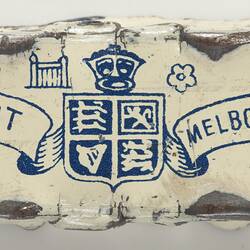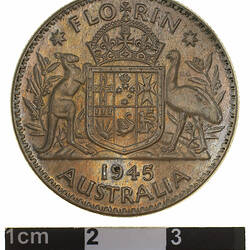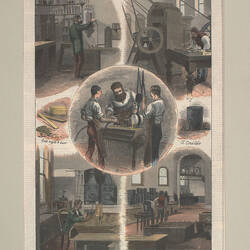Summary
Copper One Penny Token, minted by W.J. Taylor, London. Issued by A.G. Hodgson, Outfitter & Tailor, Melbourne, 1860. Alfred Hodgson came to Melbourne in 1853. He established a drapers, tailors and outfitters business in Little Lonsdale Street in 1853. Hodgson made the arrangments to issues his tokens with his business neighbour John Andrew, both men ordered their tokens through a London agent named Coard. It is thought that the dies were cut by Birmingham medallists Heaton and Sons (based on the design employed for Hide and De Carle, 1857-1858) and struck by W.J. Taylor in London. Hodgson operated his business with great success until his retirement. Hodgson visited England after his retirement and when he returned to Australia his wealth seems to have evaporated. He died aged 80, in a charitable home run by Mr. Syme of The Age.
Physical Description
A round copper token (34 mm diameter) giving the name address and business of the issuer: A.G. Hodgson 13 Lonsdale Street, Melbourne outfitter and tailor. The token features at centre of the obverse a male lion standing to left with head crowned facing front, its right paw is raised and rests on a shield bearing the Union Jack, its tail curved back over its body. On the reverse a female figure representing Justice seated on a wool bale with legs to left but her head and upper body to front. A wine barrel lies on the ground behind her, its end decorated with a cross in double incuse lines to hint at a Union Jack (as found beside Britannia on the copper coins of the period). A three-masted sailing ship sails to the right on the horizon to the left. Justice wears a blindfold and extends a balanced set of scales with her right hand. With her left she holds an inverted cornucopia from which fruits flow onto the ground. She wears an ancient-style of flowing dress bound at the waist, her left arm bare and right draped to near the elbow. It bears the date 1860. This token has been cleaned and the reverse has begun to re-tone.
Obverse Description
At centre within two concentric rings of text devided by a beaded circle, a male lion standing to left with head crowned facing front, its right paw is raised and rests on a shield bearing the Union Jack, its tail curved back over its body. Around, * 13 LONSDALE STREET * MELBOURNE; around outside this, * A.G.HODGSON * OUTFITTER AND TAILOR
Reverse Description
Female figure representing Justice seated on a wool bale with legs to left but her head and upper body to front. A wine barrel lies on the ground behind her, its end decorated with a cross in doubled incuse lines to hint at a Union Jack (as found beside Britannia on the copper coins of the period). A three-masted sailing ship sails to the right on the horizon to the left. Justice wears a blindfold and extends a balanced set of scales with her right hand. With her left she holds an inverted cornucopia from which fruits flow onto the ground. She wears an ancient-style of flowing dress bound at the waist, her left arm bare and right draped to near the elbow. Around above; MELBOURNE, VICTORIA. in exergue; 1860.
Edge Description
Plain
More Information
-
Collection Names
-
Collecting Areas
-
Acquisition Information
Transfer from Melbourne Branch of Royal Mint, 1978
-
Date Issued
1860 AD
-
Issued By
A G Hodgson - Outfitter & Tailor, 13 Lonsdale Street West, Melbourne, Greater Melbourne, Victoria, Australia, 1860
-
Mint
-
Previous Collection
-
Inscriptions
Obverse: A.G.HODGSON OUTFITTER AND TAILOR 13 LONSDALE STREET WEST MELBOURNE COARD LONDON Reverse: MELBOURNE VICTORIA 1860
-
Denomination
-
Series
-
Material
Copper
-
Axis
12
-
Classification
-
Category
-
Discipline
-
Type of item
-
Dimensions
34 mm (Outside Diameter), 15.455 g (Weight)
-
Shape
Round
-
References
The token issues of Hodgson are paralleled by those of his neighbour John Andrew. Both employed a London agent, Coard, to arrange for the production of their tokens in England. Their first issues were based on the very common Melbourne issues from 1857-58 of the firm Hide & DeCarle and the dies and 1860 production may therefore have been at Heaton & Sons, Birmingham who list the Hide & DeCarle tokens as their work. However I am now tending to feel that W.J. Taylor was responsible for the Hodgson and Andrew products. An error was made in the address of the first Hodgson tokens - the word WEST being omitted from the address. This was corrected on the dies for both penny and halfpenny denominations, although many examples of the penny were struck before the error was noticed. The reverse die for this 'address errorr' issue is different to that used after the correction (the barrel in particular is entirely drawn with raised lines whereas it is drawn with incuse lines on later work). John Andrew's issues do not contain a product from this die with the raised lines. This suggests that the Hodgson 'error address' issue was the first. With the exception of a single halfpenny (NU11279) all later work the reverse dies were shared and the barrel is drawn with incuse lines. No doubt offering a saving in production costs for the two Melbourne firms. The first penny obverse die broke from the lion's head to the shield after the address was corrected. The 1862 issue seems to have been the work of W.J. Taylor in London. It has been suggested (Sharples NAA 7 p.41 ) that the 1860 dies, which would have been the property of the company which commissioned them, were transferred to London - we know Taylor had an 1860 reverse in 1880 when he used it for collector concoctions such as the Hedberg NU 11230. However, the Hedberg re-strikes on closer examination are from the original raised line barrel die, not the normal incuse line form. A transfer of dies therefore seems an unnecissarily messy solution, more likley Taylor did the original work and still held the dies. Did both Taylor and Heaton strike Lion /Justice types? Perhaps they could both argue that they were drawing on early 19th Century British token designs. There is a rare issue for both the penny and halfpenny, sometimes called a pattern, struck with the 1860 dated reverse and the 1862 obverse bearing a simple legend with no pictorial element. These issues are again exactly paralleled by John Andrews - with comparable rarity. Heyde gives R9 and NS for the Hodgson issues and R.10 for both Andrew's pieces. The examples in the museum collection, which holds all four, have all seen extensive circulation. The British Museum received a proof strike of the Andrew's penny of this type in 1864 which further suggests that all belong to 1860 - 1862 period. - John Sharples 25 Oct 2004
[Book] Andrews, Arthur. 1921. Australasian Tokens and Coins., No. 254
[Book] Heyde, Gilbert C. & Skinner, Dion H. 1967. Unofficial Coins of Colonial Australia and New Zealand., No. 110/2
[Article] Sharples, John P. 1993. A Catalogue of the Trade Tokens of Victoria 1848 to 1862. Journal of the Numismatic Association of Australia. vol.7: p.1-77., V. 86
-
Keywords








